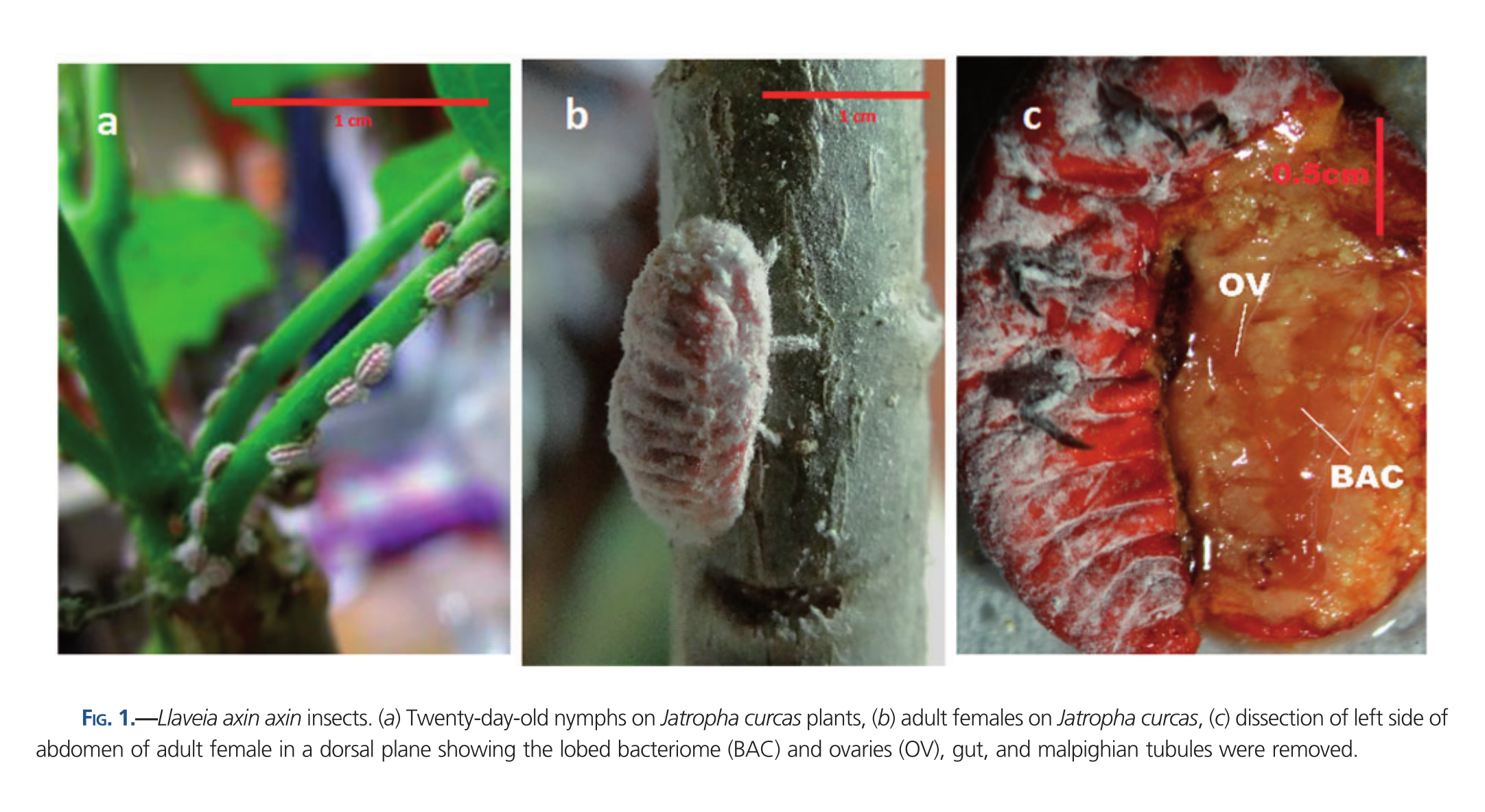Valid Names Results
Llaveia axin axin (Llave, 1832) (Monophlebidae: Llaveia)Nomenclatural History
- Coccus axin Llave 1832: 148. Type data: MEXICO: Veracruz State, Tlacotalpa and Papantla, on Jatropha curcas and Spondias myrobalanus.. Syntypes, female, accepted valid name Notes: Depository of type material unknown. Illustr.
- Coccus adipofera Donde Ibarra 1875: 175. Type data: MEXICO: Yucatan, on Spondias sp.. Syntypes, female and first instar, junior synonym (discovered by Cocker1899n, 2). Notes: Depository of type series unknown.
- Llaveia axin (Llave, 1832); Signoret 1876: 370. change of combination
- Ortonia bouvari Signoret 1876: 368. Type data: GUATEMALA: Cordillieres, host plant not indicated; collected by Mr. Aime Bouvar.. Lectotype, female, by subsequent designation (BenDov2004,384). Type depository: Vienna: Naturhistorisches Museum Wien, Austria; junior synonym (discovered by BenDov2004, 384).
- Llaveia axin; Signoret 1876: 370. subsequent use Notes: Incorrect citation of "Hernandez, Salle" as author.
- Llaveia aximus (Llave, 1832); Comstock 1883: 136. misspelling of species epithet Notes: Mis-spelling of species name and incorrect citation of "Hernandez" as author.
- Llaveia bouvari (Signoret, 1876); Cockerell 1899j: 259. change of combination
- Monophlebus axinus (Llave, 1832); Cockerell 1899n: 2. change of combination
- Monophlebus bouvari (Signoret, 1876); Cockerell 1899n: 2. change of combination
- Llaveia bouvari (Signoret, 1876); Cockerell 1902r: 319. revived combination (previously published)
- Monophlebus dugesi Vayssière 1914b: 335. Type data: MEXICO: Guanajuato, host plant not indicated; collected 1890 by M. Duges.. Syntypes, female, Type depository: Paris: Museum National d'Histoire naturelle, France; junior synonym (discovered by Vayssi1926, 300).
- Llavea bouvari; Lindinger 1955a: 343. misspelling of genus name
Common Names
- aje Jenkin1970
- axin Jenkin1970
- ni-in Jenkin1970
- nij Jenkin1970
- nije Jenkin1970
Ecological Associates
Hosts:
Families: 3 | Genera: 6
- Anacardiaceae
- Schinus | Foldi1995a
- Spondias | DondeI1875 RosasPRoRi2014
- Spondias dulcis | Foldi1995a Jenkin1970
- Spondias mombin | Llave1832 Signor1876
- Euphorbiaceae
- Jatropha curcas | Jenkin1970 Llave1832 RosasPRoRi2014 Signor1876
- Fabaceae
- Acacia | Foldi1995a
- Acacia cochliacantha | Jenkin1970
- Acaciella | Jenkin1970 RosasPRoRi2014
- Erythrina americana | Jenkin1970
Geographic Distribution
Countries: 2
- Guatemala | Jenkin1970 | Cocker1899n Signor1876 Vayssi1926
- Mexico | Foldi1995a Signor1876 Vayssi1926
- Chiapas | CaballRa2018 Jenkin1970
- Guanajuato | Vayssi1914b
- Michoacan | Jenkin1970
- Veracruz | Jenkin1970 Llave1832
- Yucatan | DondeI1875 Jenkin1970
Keys
- Morris1928: pp.189 ( Adult (F) ) [Species of Llaveia]
Remarks
- Systematics: Vayssière (1926) synonymized Monophlebus dugesi Vayssière, 1914, with Llaveia axin. Later he noted that it is very likely that Monophlebus dugesi Vayssière is identical with Llaveia axin var. dorsalis Duges.
- Structure: The adult female measures up to 25 mm long (Llave, 1832; Signoret, 1876). Colour photograph of adult female by MacGregor-Loayza (1969) and by Foldi (2003b).
- Biology: Develops one annual generation in Mexico. Crawlers emerge in early spring, and fully grown female (ready for harvesting) appear in September-November (Jenkins, 1970).
- Economic Importance: The native people of Mexico and Central America cultivate this coccoid, and use the fat extraction from adult females as a lacquer for waterproofing various tools and as a base for medicines and cosmetics (Jenkins, 1970; Williams & MacVean, 1995).
- General Remarks: Description and illustration of adult female by Llave (1832), Signoret (1876), Vayssière (1914b, 1926).
Illustrations
Citations
- Anoiin1880: chemistry, distribution, economic importance, host, taxonomy, 10
- BenDov2004: distribution, host, taxonomy, 383-386
- BenDov2005a: catalog, distribution, economic importance, host, taxonomy, 231-232
- Blanch1883: chemistry, distribution, economic importance, life history, taxonomy, 303-305
- CaballRa2018: distribution, 2
- CasonDaSh1971: chemistry, 2621-2625
- Cocker1897u: distribution, host, taxonomy, 271
- Cocker1899j: taxonomy, 259
- Cocker1899n: distribution, host, taxonomy, 2
- Cocker1902o: taxonomy, 79
- Cocker1902q: distribution, taxonomy, 232
- Cocker1902r: taxonomy, 319
- Comsto1883: distribution, economic importance, host, taxonomy, 136
- DondeI1875: description, distribution, host, taxonomy, 174-180
- Fernal1903b: 17
- Foldi1995a: distribution, host, 176
- Foldi2001a: taxonomy, 206
- Foldi2003b: taxonomy, 28
- Foldi2016: taxonomy, 291
- Gavril2018: cytogenetics, illustration, 10,27
- Gavril2025: biology, chemical, diagnosis, history, illustration, taxonomy, 252
- Hughes1931: chromosomes, structure, taxonomy, 742-769
- Jenkin1970: distribution, economic importance, host, life history, taxonomy, 79-81
- KondoGu2022: economic importance, 3
- Koszta1987: economic importance, 218
- Lindin1955a: taxonomy, 341-344
- Llave1832: description, distribution, host, illustration, taxonomy, 147-152
- Llave1861: description, distribution, host, taxonomy, 374-379
- MacGre1969: distribution, host, taxonomy, 1-203
- MacVea1999: distribution, economic importance, 90-93
- MacVeaCaLl1999: distribution, economic importance, 126
- MacVeaScCa2001: distribution, economic importance, host, 1-7
- Macvea1994: distribution, economic importance, life history,
- Morris1928: taxonomy, 182-183,188-189,222
- PerezMaWi2005: taxonomy, 18
- RosasPRoRi2014: distribution, economic, illustration, importance, life history,
- RosasPRoRi2014: endosymbiont,
- RosenbSaSa2012: ecology, molecular data, physiology, 2357-2368
- Sassce1915: distribution, host, taxonomy, 26
- Signor1869: catalog, taxonomy, 844
- Signor1876: description, distribution, host, taxonomy, 370-372
- Vayssi1914b: description, distribution, taxonomy, 335-336
- Vayssi1926: description, distribution, host, illustration, taxonomy, 300-305
- Willia2017a: catalog, list of species, 242
- WilliaBe2009: catalog, taxonomy, 7,10
- WilliaMa1995: distribution, economic importance, taxonomy, 147-148



